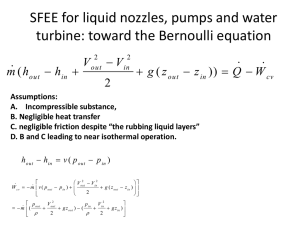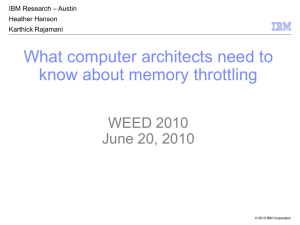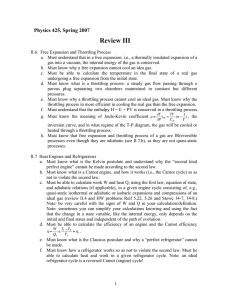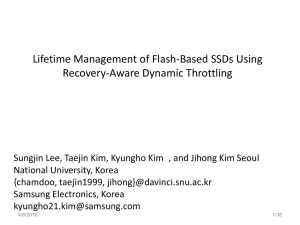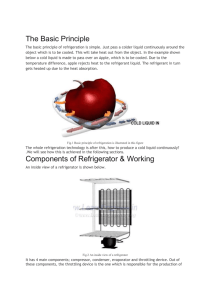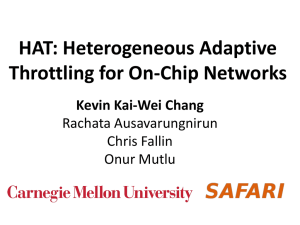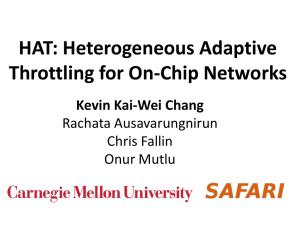HAT: Heterogeneous Adaptive Throttling for On-Chip Networks Kevin Kai-Wei Chang, Rachata Ausavarungnirun,
advertisement
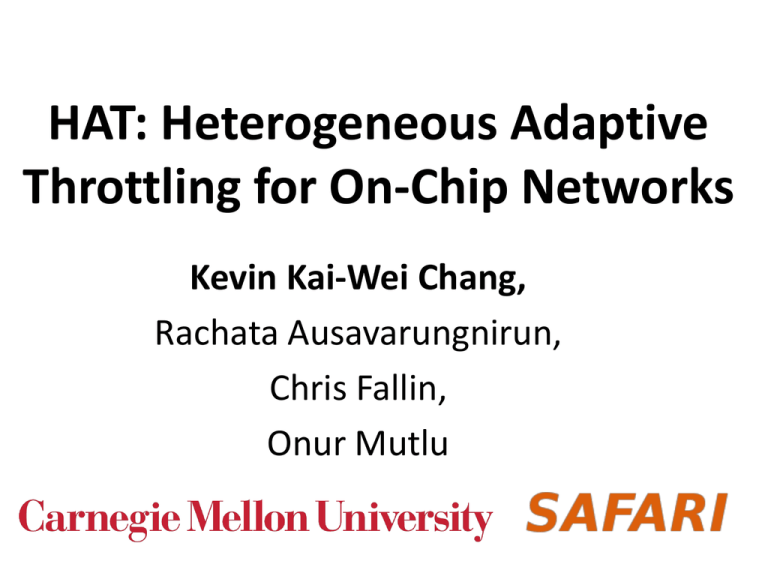
HAT: Heterogeneous Adaptive Throttling for On-Chip Networks Kevin Kai-Wei Chang, Rachata Ausavarungnirun, Chris Fallin, Onur Mutlu Executive Summary • Problem: Packets contend in on-chip networks (NoCs), causing congestion, thus reducing performance • Observations: 1) Some applications are more sensitive to network latency than others 2) Applications must be throttled differently to achieve peak performance • Key Idea: Heterogeneous Adaptive Throttling (HAT) 1) Application-aware source throttling 2) Network-load-aware throttling rate adjustment • Result: Improves performance and energy efficiency over state-of-the-art source throttling policies 2 Outline • Background and Motivation • Mechanism • Prior Works • Results 3 On-Chip Networks PE PE R PE R PE R PE PE R PE R PE R R PE R PE R R Router Processing Element • Connect cores, caches, memory controllers, etc • Packet switched • 2D mesh: Most commonly used topology • Primarily serve cache misses and memory requests • Router designs – Buffered: Input buffers to hold contending packets – Bufferless: Misroute (deflect) contending packets (Cores, L2 Banks, Memory Controllers, etc) 4 Network Congestion Reduces Performance PE PE P R PE R P PE PE P R R PEP R Limited shared resources (buffers and links) • Design constraints: power, chip area, and timing R Network congestion: PE PE P R R PE PE R R Network throughput Application performance Router Packet P Processing Element (Cores, L2 Banks, Memory Controllers, etc) 5 Goal • Improve performance in a highly congested NoC • Reducing network load decreases network congestion, hence improves performance • Approach: source throttling to reduce network load – Temporarily delay new traffic injection • Naïve mechanism: throttle every single node 6 Key Observation #1 Different applications respond differently to changes in network latency gromacs: network-non-intensive mcf: network-intensive Normalized Performance 1.2 - 2% 1.0 + 9% 0.8 Throttle gromacs Throttle mcf 0.6 0.4 0.2 0.0 mcf gromacs system Throttling reduces congestion Throttlingmcf network-intensive applications benefits gromacs is more sensitive system performance moreto network latency 7 Key Observation #2 Performance (Weighted Speedup) Different workloads achieve peak performance at different throttling rates 16 15 14 13 12 11 10 9 8 7 6 90% 92% Workload 1 Workload 2 Workload 3 80 82 84 86 94% 88 90 92 94 Throttling Rate (%) 96 98 Dynamically adjusting throttling rate yields better performance than a single static rate 100 8 Outline • Background and Motivation • Mechanism • Prior Works • Results 9 Heterogeneous Adaptive Throttling (HAT) 1. Application-aware throttling: Throttle network-intensive applications that interfere with network-non-intensive applications 2. Network-load-aware throttling rate adjustment: Dynamically adjusts throttling rate to adapt to different workloads 10 Heterogeneous Adaptive Throttling (HAT) 1. Application-aware throttling: Throttle network-intensive applications that interfere with network-non-intensive applications 2. Network-load-aware throttling rate adjustment: Dynamically adjusts throttling rate to adapt to different workloads 11 Application-Aware Throttling 1. Measure Network Intensity Use L1 MPKI (misses per thousand instructions) to estimate network intensity 2. Classify Application Sort applications by L1 MPKI Network-intensive App Network-non-intensive Σ MPKI < NonIntensiveCap Higher L1 MPKI 3. Throttle network-intensive applications 12 Heterogeneous Adaptive Throttling (HAT) 1. Application-aware throttling: Throttle network-intensive applications that interfere with network-non-intensive applications 2. Network-load-aware throttling rate adjustment: Dynamically adjusts throttling rate to adapt to different workloads 13 Dynamic Throttling Rate Adjustment • For a given network design, peak performance tends to occur at a fixed network load point • Dynamically adjust throttling rate to achieve that network load point 14 Dynamic Throttling Rate Adjustment • Goal: maintain network load at a peak performance point 1. Measure network load 2. Compare and adjust throttling rate If network load > peak point: Increase throttling rate elif network load ≤ peak point: Decrease throttling rate 15 Epoch-Based Operation • Continuous HAT operation is expensive • Solution: performs HAT at epoch granularity During epoch: Beginning of epoch: 1) Measure L1 MPKI of each application 2) Measure network load 1) Classify applications 2) Adjust throttling rate 3) Reset measurements Time Current Epoch (100K cycles) Next Epoch (100K cycles) 16 Outline • Background and Motivation • Mechanism • Prior Works • Results 17 Prior Source Throttling Works • Source throttling for bufferless NoCs [Nychis+ Hotnets’10, SIGCOMM’12] – Application-aware throttling based on starvation rate – Does not adaptively adjust throttling rate – “Heterogeneous Throttling” • Source throttlinr off-chip buffered networks [Thottethodi+ HPCA’01] – Dynamically trigger throttling based on fraction of buffer occupancy – Not application-aware: fully block packet injections of every node – “Self-tuned Throttling” 18 Outline • Background and Motivation • Mechanism • Prior Works • Results 19 Methodology • Chip Multiprocessor Simulator – 64-node multi-core systems with a 2D-mesh topology – Closed-loop core/cache/NoC cycle-level model – 64KB L1, perfect L2 (always hits to stress NoC) • Router Designs – Virtual-channel buffered router: 4 VCs, 4 flits/VC [Dally+ IEEE TPDS’92] – Bufferless deflection routers: BLESS [Moscibroda+ ISCA’09] • Workloads – 60 multi-core workloads: SPEC CPU2006 benchmarks – Categorized based on their network intensity • Low/Medium/High intensity categories • Metrics: Weighted Speedup (perf.), perf./Watt (energy eff.), and maximum slowdown (fairness) 20 Weighted Speedup Performance: Bufferless NoC (BLESS) 50 45 40 35 30 25 20 15 10 5 0 BLESS Hetero. HAT HL HML HM Workload Categories H 7.4% amean HAT provides better performance improvement than past work Highest improvement on heterogeneous workload mixes - L and M are more sensitive to network latency 21 Weighted Speedup Performance: Buffered NoC 50 45 40 35 30 25 20 15 10 5 0 Buffered Self-Tuned Hetero. HAT HL HML HM Workload Categories H + 3.5% amean Congestion is much lower in Buffered NoC, but HAT still provides performance benefit 22 Application Fairness Normalized Maximum Slowdwon BLESS Hetero. Buffered Hetero. HAT 1.2 1.2 1.0 1.0 - 15% 0.8 0.8 0.6 0.6 0.4 0.4 0.2 0.2 0.0 0.0 amean Self-Tuned HAT - 5% amean HAT provides better fairness than prior works 23 Network Energy Efficiency Normalized Perf. per Wat 1.2 8.5% 5% 1.0 0.8 Baseline 0.6 HAT 0.4 0.2 0.0 BLESS Buffered HAT increases energy efficiency by reducing congestion 24 Other Results in Paper • Performance on CHIPPER • Performance on multithreaded workloads • Parameters sensitivity sweep of HAT 25 Conclusion • Problem: Packets contend in on-chip networks (NoCs), causing congestion, thus reducing performance • Observations: 1) Some applications are more sensitive to network latency than others 2) Applications must be throttled differently to achieve peak performance • Key Idea: Heterogeneous Adaptive Throttling (HAT) 1) Application-aware source throttling 2) Network-load-aware throttling rate adjustment • Result: Improves performance and energy efficiency over state-of-the-art source throttling policies 26 HAT: Heterogeneous Adaptive Throttling for On-Chip Networks Kevin Kai-Wei Chang, Rachata Ausavarungnirun, Chris Fallin, Onur Mutlu Throttling Rate Steps 28 Overhead 29 Multithreaded Workloads 30
